Final version for distribution:
Updated 4/27/2020 - View file name LFN_TAC_Whitepaper_V3.pdf height 250
Meetings - Every other Friday, 8AM PST
Audience: internal or external
Goals: to identify where projects fit in the open source landscape, identify similarities and gaps of projects, in that landscape and look for dependencies and touchpoints between projects.
- Describe the functionality of each project
- Describe the interfaces
Target audience: Pre-requisites - NFV, SDN, Network automation...
Dates:
Tentative delivery date March-31/20202020
Draft dates:
Section 3 - No later than Mid January
Remaining sections - Mid February
1. Work group members and areas of expertise
| Name | FD.IO | ONAP | OPNFV | ODL | Open Switch | SNAS | PNDA | Tungsten Fabric | CNTT | CVC | |
|---|---|---|---|---|---|---|---|---|---|---|---|
Ranny Haiby(lead) | ++++ | + | |||||||||
| + | + | + | ++++ | ||||||||
| ++++ | + | + | |||||||||
| +++ | + | ||||||||||
| + | + | + | + | ||||||||
| ++++ | + | + | |||||||||
| ++++ | |||||||||||
| + | + | +++ | |||||||||
| Fernando Oliveira | ++ | ++++ | + | ++ | + | + | + | + | |||
laurence plant (reviewer) | |||||||||||
| Donald Hunter | ++++ | ||||||||||
| ++ | +++ | ++++ | ++++ | ||||||||
| Hiroshi Dempo | Bin Hu++ | ++ | + | ||||||||
| Al Morton | + | Davide Cherubini++ | ++++ | ++ | + | ++ | +++tom nadeau |
++++ - Expert knowledge
+++ - Very good knowledge
...
<blank> - Heard about it, but not sure what it does exactly
2. Architecture diagram
External landscape:
Internal Architecture:
Contacts for identifying experts:
SNAS- Trishan de Lanerolle
2
...
. White paper outline
...
- Industry trends, open source in networking, etc.
- Reasoning for the need for LFN
- Goals of LFN
...
- Definition of the various layers and domains
- Mapping of projects to domains
...
See the Table of Contents
3. Diagrams
3. Architecture diagram
External landscape:
Internal Architecture:
Project relationship diagram
...
For each <project> in <LFN> describe (goals, technologies, key features, etc.)
...
- Inter dependencies
- Integration points
- Functional flows
...

